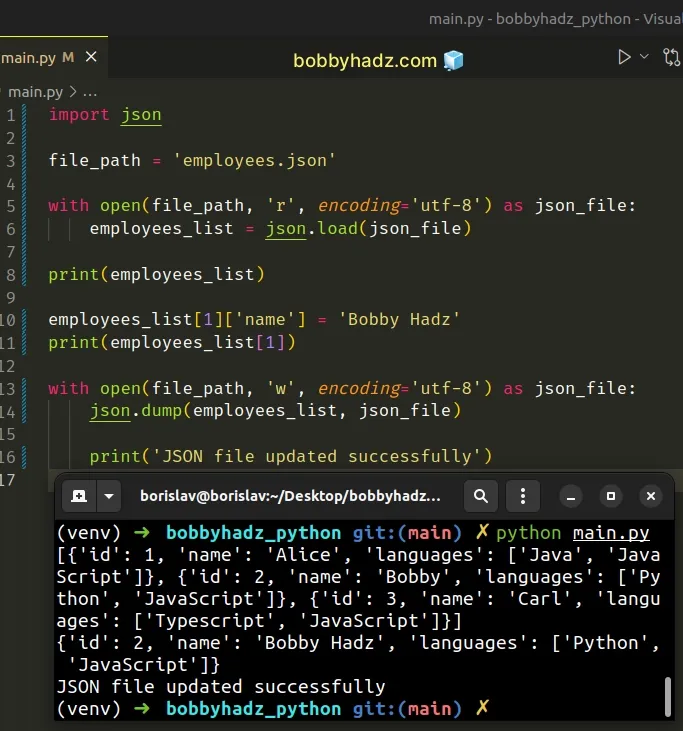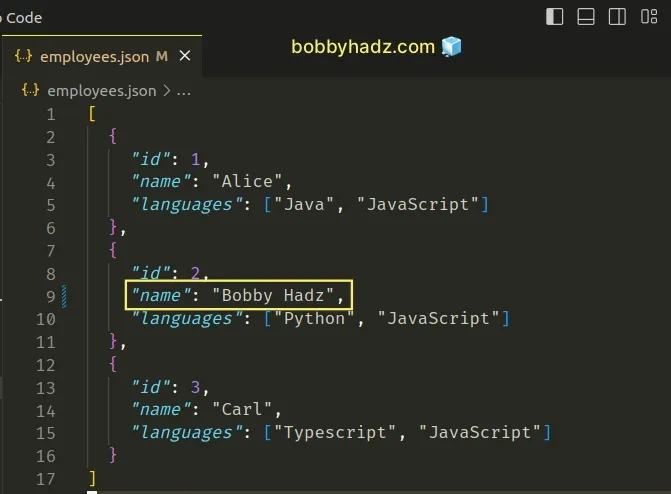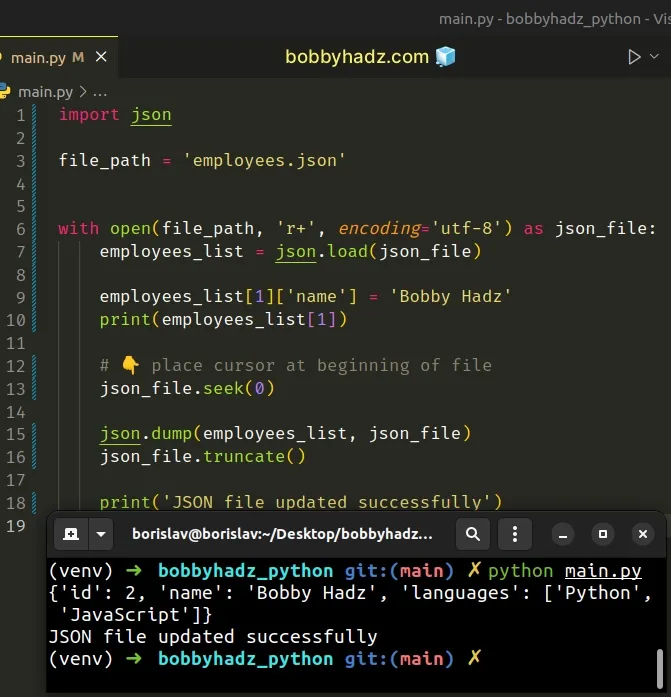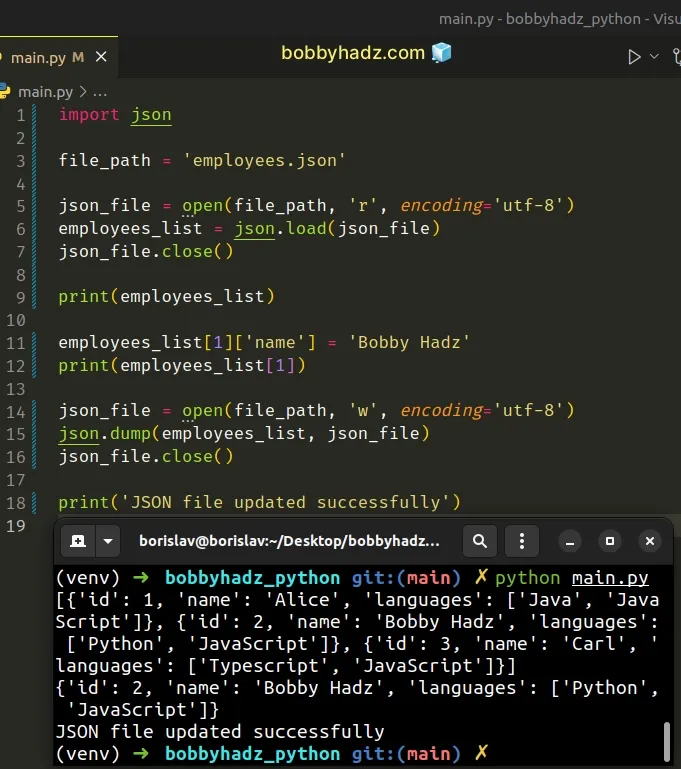How to update a JSON file in Python [3 Ways]
Last updated: Apr 11, 2024
Reading time·4 min

# Table of Contents
- How to update a JSON file in Python
- Update a JSON file by opening it in
r+mode - Updating a JSON file in Python by opening it directly
# How to update a JSON file in Python
To update a JSON file in Python:
- Use the
with open()statement to open the file in reading mode. - Read the file's contents.
- Update the JSON list or dictionary.
- Open the file in writing mode and write the updated value to the file.
The code sample uses the following employees.json starting file.
[ { "id": 1, "name": "Alice", "languages": ["Java", "JavaScript"] }, { "id": 2, "name": "Bobby", "languages": ["Python", "JavaScript"] }, { "id": 3, "name": "Carl", "languages": ["Typescript", "JavaScript"] } ]
And here is the related Python code.
import json file_path = 'employees.json' with open(file_path, 'r', encoding='utf-8') as json_file: employees_list = json.load(json_file) print(employees_list) employees_list[1]['name'] = 'Bobby Hadz' print(employees_list[1]) with open(file_path, 'w', encoding='utf-8') as json_file: json.dump(employees_list, json_file) print('JSON file updated successfully')

We used the with open()
statement to open the .json file in r (reading) mode.
The json.load() method is used to deserialize a file to a Python object.
import json file_path = 'employees.json' with open(file_path, 'r', encoding='utf-8') as json_file: employees_list = json.load(json_file)
Note that we used json.load() and not json.loads().
The json.loads() method is used to deserialize a JSON string (not a file) to a Python object.
The next step is to update the values in the list or dictionary (depending on your file's contents).
print(employees_list) employees_list[1]['name'] = 'Bobby Hadz' print(employees_list[1])
Once the values in the object are updated, you have to open the file in w
(writing) mode.
with open(file_path, 'w', encoding='utf-8') as json_file: json.dump(employees_list, json_file) print('JSON file updated successfully')
The json.dump() method serializes the supplied object as a JSON formatted stream and writes it to a file.
Notice that we used json.dump() and not json.dumps().
The json.dumps() method converts a Python object (not a file) to a JSON formatted string.
After issuing the python main.py command, I can see that the JSON file has
been updated successfully.

# Update a JSON file by opening it in r+ mode
You can also update a JSON file by opening it in r+ (reading and writing)
mode.
This should be a bit more performant because you only have to open the file once.
The code sample uses the following employees.json starting file.
[ { "id": 1, "name": "Alice", "languages": ["Java", "JavaScript"] }, { "id": 2, "name": "Bobby", "languages": ["Python", "JavaScript"] }, { "id": 3, "name": "Carl", "languages": ["Typescript", "JavaScript"] } ]
And here is the related Python code.
import json file_path = 'employees.json' with open(file_path, 'r+', encoding='utf-8') as json_file: employees_list = json.load(json_file) employees_list[1]['name'] = 'Bobby Hadz' print(employees_list[1]) # 👇️ place the cursor at the beginning of the file json_file.seek(0) json.dump(employees_list, json_file) json_file.truncate() print('JSON file updated successfully')

The r+ mode opens the file in reading and writing mode.
We first convert the JSON file to a native Python object using json.load().
The next step is to update the Python object.
with open(file_path, 'r+', encoding='utf-8') as json_file: employees_list = json.load(json_file) employees_list[1]['name'] = 'Bobby Hadz' print(employees_list[1])
However, at this point, we've read the contents of the file, so the cursor is placed at the end.
We have to use the file.seek() method to place the cursor at the beginning of
the file.
# 👇️ place the cursor at the beginning of the file json_file.seek(0)
Once the cursor is at the beginning, we write the updated Python object to the file.
json.dump(employees_list, json_file) json_file.truncate()
The file.truncate() method is used to cover the case where the updated
contents of the file are fewer bytes.
# Updating a JSON file in Python by opening it directly
The previous examples used the with statement to open the file, however, you
can also use the open() function directly.
The code sample uses the same employees.json starting file.
[ { "id": 1, "name": "Alice", "languages": ["Java", "JavaScript"] }, { "id": 2, "name": "Bobby", "languages": ["Python", "JavaScript"] }, { "id": 3, "name": "Carl", "languages": ["Typescript", "JavaScript"] } ]
And here is the related Python code.
import json file_path = 'employees.json' json_file = open(file_path, 'r', encoding='utf-8') employees_list = json.load(json_file) json_file.close() print(employees_list) employees_list[1]['name'] = 'Bobby Hadz' print(employees_list[1]) json_file = open(file_path, 'w', encoding='utf-8') json.dump(employees_list, json_file) json_file.close() print('JSON file updated successfully')

We used the open() function directly in the code sample.
When using the with open() statement, Python automatically takes care of
closing the file, even if an error is raised.
When you use the open() function directly, you have to manually close the
file.
If you forget to close the file after you're done reading/writing, you'll get a memory leak.
I've also written an article on how to merge JSON files in Python.
# Additional Resources
You can learn more about the related topics by checking out the following tutorials:
- Count number of unique Words in a String or File in Python
- Create a file name using Variables in Python
- How to get the File path of a Class in Python
- Taking a file path from user input in Python
- How to check if a File is Empty in Python
- NameError: name '__file__ is not defined in Python [Fixed]
- Write a String to a File on a New Line every time in Python
- How to unzip a .gz file using Python [5 simple Ways]
- How to merge text files in Python [5 simple Ways]
- How to create a Zip archive of a Directory in Python

